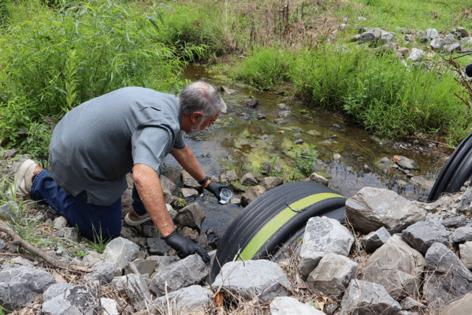Lara Williams: Stop playing whac-a-mole with forever chemicals
Published in Op Eds
The more you learn about PFAS — per- and polyfluoroalkyl substances — the worse it gets. Though improvements in monitoring and remediation techniques are welcome, what the world needs first and foremost is a universal ban on the chemicals. In fact, we needed it yesterday.
There are more than 10,000 PFAS, also known as “forever chemicals,” and they’re used almost everywhere, including in nonstick cookware, waterproof clothing, smartphones, packets of microwave popcorn, hair conditioners, fire-fighting foam, pacemakers, pesticides and dental floss.
They don’t readily degrade; they also don’t stay where we put them. As a result, we can now find PFAS in places such as our blood, human breast milk, Antarctica, wild animals and tap water. In the Netherlands, people have been warned not to eat the eggs from their backyard chickens by the National Institute for Public Health and the Environment due to high levels of the chemicals. Though it’s not yet clear why home-produced eggs have higher amounts of PFAS than commercial ones, one theory is that earthworms now contain such chemicals, and hens like to eat the worms.
An analysis by environmental groups Wildlife and Countryside Link and the Rivers Trust found that nearly all rivers, lakes and ponds in England exceed proposed safety limits, with 85% containing levels at least five times higher. France has banned tap water in 16 communes due to PFAS contamination, while a piece of investigative journalism called the Forever Pollution Project located 23,000 contaminated sites across Europe and a further 21,500 sites of presumptive contamination. I expect we haven’t seen the last of the tap water bans.
If the scale and extent of the pollution are hard to get your head around, the health implications are worse. PFAS have been linked to increased risk of various types of cancer, fertility problems, birth complications, delays to puberty and weakened immune systems. They’ve also been associated with increased cholesterol levels and kidney problems.
We’re looking at an issue analogous to climate change — right down to lobbying and cover-ups by PFAS manufacturers. Internal documents from 3M Co., one of the original and largest producers, and chemical firm DuPont de Nemours Inc. revealed that the companies knew the substances were accumulating in people and showing signs of toxicity for decades without telling anyone.
While 3M still maintains that their PFAS-containing products are “safe” for their intended uses in everyday life, in December 2022 the company announced it will discontinue the use of PFAS by the end of 2025. Together, the firms have had to pay billions in lawsuit settlements related to their pollution, with more possibly to come as injury cases hit the courts.
As with carbon dioxide, the longer we keep emitting PFAS into the environment, the worse the problem gets and the harder it is to clean up with remediation technologies. While the PFAS market globally is worth just over $28 billion, the cost of cleaning up all the related pollution in the UK and Europe could be €100 billion ($116 billion) a year if nothing is done to stem the chemicals’ steady flow into the environment. And that doesn’t factor in the health-care costs, which the Nordic Council of Ministers estimates is at least €52 billion annually.
Though some consumer brands such as outdoor gear retailer Patagonia Inc. and fast-food chain McDonald’s Corp. have committed to phasing out PFAS from their products and packaging, others have been dragging their feet. A team of researchers, lawyers and journalists has also exposed a huge lobbying campaign against proposed restrictions in Europe, showing entrenched resistance to change.
So we need a ban, but so far, we’ve only seen piecemeal prohibitions targeting either a specific chemical or, in a couple of leading countries, sectors.
The import and sale of PFAS-treated clothing, shoes and waterproofing agents will be barred from July 2026 in Denmark, while the chemicals have been banned in paper and board food packaging since 2020. The country has also recently announced a ban on 23 pesticides that can form a very mobile form of PFAS called trifluoroacetic acid.
France, meanwhile, has banned PFAS in several consumer product groups, including textiles, cosmetics and ski wax. Cookware, however, has been excluded from the ban after a campaign led by the French maker of Tefal pans, Groupe SEB. Though it’s a start, exempting a sector for which safe alternatives are readily available is, frankly, scandalous.
A universal ban may be on its way. In 2023, five European Union member states — Germany, the Netherlands, Sweden, Denmark and Norway — submitted a proposal to the European Chemicals Agency, which two scientific committees are now examining. The ban covers both consumer and industrial applications, with time-limited exemptions expected for some uses where there are no alternatives, such as medical devices.
What’s most significant about the restriction is that it takes a precautionary approach, regulating all 10,000-plus PFAS as a group rather than individually. According to CHEM Trust, a charity focused on harmful synthetic chemicals, under the current rate of regulation that analyzes each chemical individually, it would take more than 40,000 years to get through them all.
So the EU ban will be a huge step forward with positive impacts beyond its borders. But we’ll be waiting a while for it to come into effect — if everything goes smoothly, we’re likely looking at 2028 before sectors transition to new rules.
Meanwhile, progress elsewhere is pitiful. The UK government published an interim position on PFAS management in June, but this has been criticized by scientists for opting not to target all chemicals at once and instead creating their own groupings. Not only is this risky, failing to regulate compounds that lack toxicity data, but it lacks urgency. In the U.S., the Trump administration has pulled nearly $15 million in research into PFAS contamination of farmland, while the Environmental Protection Agency has announced plans to rescind drinking water limits for four forever chemicals.
Of course, even banning the use of all PFAS tomorrow won’t do anything for the substances already in our bodies and drinking water. But we know that restrictions help. Two chemicals — PFOS and PFOA — are already banned in Europe. A 2023 study showed that blood concentrations of the chemicals have declined substantially over time in Denmark.
It’s time to stop playing Whac-a-Mole with chemicals that we know are bad for us and our environment. If we take action now, we might stand a chance at cleaning up the mess we’ve made.
_____
This column reflects the personal views of the author and does not necessarily reflect the opinion of the editorial board or Bloomberg LP and its owners.
Lara Williams is a Bloomberg Opinion columnist covering climate change.
_____
©2025 Bloomberg L.P. Visit bloomberg.com/opinion. Distributed by Tribune Content Agency, LLC.

























































Comments